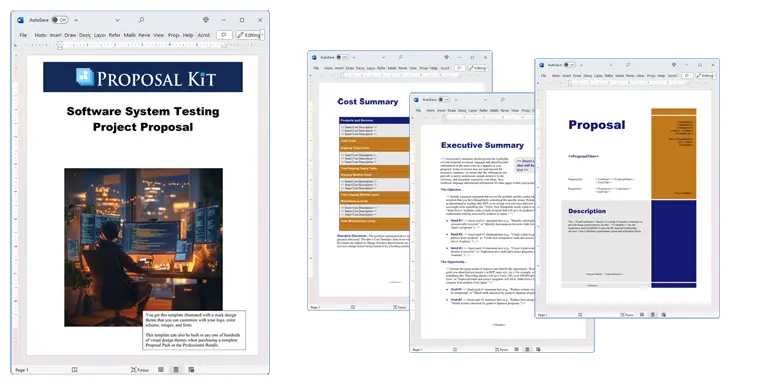How to write your Software System Testing Project Proposal
We include this 21 page layout with every Proposal Pack. If you want this template to have a different visual design theme than the one illustrated here, purchase any Proposal Pack design and create this template using the purchased design theme. This template is included in every Proposal Pack. If you get a Proposal Pack or the Professional, you can also make any variation of this template with different chapters to suit your needs.
We typically include more chapters in the templates than most people will need to give everyone more variety in the chapters they may need. You can trim down a long template by removing pages you do not need or combining multiple chapter topics into one page.
 DOWNLOADABLE, ONE-TIME COST, NO SUBSCRIPTION FEES
DOWNLOADABLE, ONE-TIME COST, NO SUBSCRIPTION FEES If you need only this template pre-assembled on DVD media order from our Amazon shop.
If you need only this template pre-assembled on DVD media order from our Amazon shop.
You can also create countless variations of this document to suit your needs using the included library of 2200+ chapters if ordering a Proposal Pack or Professional.
 What Our Clients Say
What Our Clients SayThe Business Proposal software package was easy to install and very intuitive. The content is full of great ideas and has something for everyone at a very reasonable price."
ERM/ECM Specialist
Related Article
Related Video
Related Templates
- Software Beta Testing Project Proposal
- Software Installation and Training Proposal
- Network Software Installation Proposal
- Software Automation Proposal
- Small Business Web Site Project Proposal
- Cloud Computing Services Proposal
- Software Licensing Sales Proposal
- Prescription Monitoring Software Proposal
- Training Services for Software Proposal
- IT Disaster Recovery Services Proposal
- CD-ROM Development Proposal
- Multilingual Web Site and DVD Proposal
- Large Web Site and CD-ROM Project
- Software and Hardware System Proposal
- Software as a Service (SAAS) Proposal
- Custom Software Development Proposal
- Defense Contracting Intelligence System Proposal
- Mobile App Software Development Proposal
- Sales and Inventory System Development Proposal
- Web Site Creation and Software Integration Project
- Micro Web Site Project Proposal
- IT Equipment Maintenance and Repair Services Proposal
- ERP (Enterprise Resource Planning) System Proposal
- Mobile App Development Proposal Template
- Managed Services IT Proposal
- FinTech System Integration Proposal Template
- AI Driven Social Media Analytics Proposal Template
- Machine Learning Research Proposal Template
- AI For Financial Fraud Detection Proposal Template
- Artificial Intelligence Proposal Template
- Chatbot Services Proposal Template
- AI Driven Health Diagnostics Proposal Template
- App Development Proposal Template
- Testing and Inspection Services Proposal
- Chatbot Development Proposal Template
- AI Based Content Creation Proposal Template
- FinTech Managed Services Sales Proposal Template
- AI Based Fitness Coaching Platforms Proposal Template
- AI Proposal Template
- Artificial Intelligence Project Funding Proposal
- IT Operations Finance Banking Proposal Template
What's the Best Way to Write Your Software System Testing Project Proposal?
Proposal Kit is a proven solution with its comprehensive template library and Wizard software program for writting a software testing proposal. The Proposal Kit not only provides customizable templates but also incorporates a line item quoting database system for cost summaries, quotes, estimates, budgets, and other financial topics. This means you can easily include all necessary financial details in your proposal.
Do you need to write a proposal for a complex software testing project? If so, Proposal Kit is designed for you.
The Proposal Kit Professional also includes contract templates for software testing agreements and software testing plans to go with your proposal.
What Types of Projects Are Software System Testing Project Proposal Written For?
Software testing proposals are used for a wide range of projects. Here are some examples of situations where these proposals are written:
- Testing new software applications before launch
- Conducting performance testing on existing software
- Ensuring system compatibility across multiple platforms
- Validating security protocols in software systems
- Performing user acceptance testing for enterprise applications
- Evaluating software updates and patches
- Assessing software compliance with industry standards
- Conducting regression testing after software changes
- Managing beta testing of new products
- Implementing automated testing processes
- Carrying out load testing to measure software scalability
- Testing the integration of software with hardware components
- Ensuring software meets accessibility requirements
- Validating data migration processes during software upgrades
- Analyzing software user interface performance
- Checking software functionality in diverse environments
- Conducting disaster recovery testing for software systems
- Testing mobile applications across various devices
- Reviewing cloud-based software performance
- Verifying software for compatibility with new operating systems
Chapters this template is built with
There is no one-size-fits-all premade template for creating a software testing proposal that fits every situation. This is why the Proposal Kit software allows you to tailor templates to cover a multitude of situations, using its extensive library of thousands of chapters. Below is a starting point, showcasing a selection of chapter templates you might use in this type of proposal:
Cover Letter
This chapter introduces your proposal and outlines your intent. It's your chance to make a strong first impression and briefly explain why your proposal is worth considering. For a software system testing project, the cover letter can highlight your expertise in software testing, emphasize the importance of the project, and express your commitment to delivering thorough and reliable testing services.
Executive Summary
Here, you summarize the key topics of your proposal. It should be concise and highlight the objectives, benefits, and expected outcomes of the project. Considering the situation of software system testing, the executive summary should succinctly outline how the testing will improve system reliability, enhance performance, and mitigate risks, ultimately leading to increased user satisfaction.
Estimate
Include a detailed cost estimation using the line item quoting database. This section provides clarity on financial expectations and demonstrates transparency. For software system testing, the estimate should break down costs associated with different testing phases, such as unit testing, integration testing, and performance testing, to provide a comprehensive view of the financial scope.
Needs Assessment
Outline the specific needs that the software testing project aims to address. This chapter helps establish the relevance and necessity of the testing initiative. In a software system testing proposal, the needs assessment should identify potential vulnerabilities, performance bottlenecks, or compliance issues that the testing will aim to resolve.
Goals and Objectives
Clearly define what the testing project intends to achieve. This helps in setting clear expectations and measurable targets. For a software testing project, goals might include achieving a certain level of test coverage, reducing defect rates, or enhancing system scalability.
Project Deliverables
List the tangible outcomes from the project, such as reports, data analyses, or software patches. This section clarifies what stakeholders can expect upon project completion. Deliverables for a software testing project may include detailed test reports, defect logs, and validated test scripts.
Testing Plan
Detail the testing methodologies, tools, and timelines. This chapter ensures that all parties are informed about how testing will be conducted. In a software testing proposal, this could involve specifying the use of automated testing tools, manual testing procedures, or specific frameworks like Agile or DevOps.
Time Line
Provide a timeline for the project, including milestones and deadlines. This helps in managing expectations and monitoring progress. For software system testing, the timeline should outline key phases such as the initial test setup, execution periods for different test types, and final review sessions.
Hardware and Software
Identify the hardware and software resources required for the testing project. This section ensures that all technical needs are accounted for. This might include specifying the need for particular operating systems, testing environments, or specialized testing tools that are important for the project.
Evaluation
Discuss how the testing results will be evaluated. This chapter sets the criteria for success and lays out the next steps post-testing. In a software testing proposal, evaluation criteria might include metrics such as defect detection efficiency, test execution time, or system performance benchmarks.
System Requirements
List the system specifications needed for the testing process. This ensures that the testing environment is adequately prepared. For a software testing project, system requirements could detail the necessary server configurations, network bandwidth, or compatible software versions.
Test Requirements
Detail the specific conditions and parameters under which the testing will take place. This chapter defines the scope and boundaries of the testing project. Test requirements might include user situations to be tested, load conditions, or specific compliance standards to be met.
Results
Present the findings and data collected from the testing process. This section is crucial for demonstrating the outcomes of the project. The results chapter should include data visualizations, summaries of detected issues, and insights into system performance improvements.
Acceptance Criteria
Establish the standards that must be met for the testing project to be deemed successful. This chapter ensures that all stakeholders agree on what success looks like. Acceptance criteria might involve specific performance thresholds, defect rates, or user acceptance benchmarks.
Recommendations
Based on the testing results, provide actionable recommendations. This section offers insights into the next steps or improvements needed. Recommendations might suggest further optimizations, additional testing phases, or enhancements to system components.
Qualifications
Highlight the qualifications of your team to build trust and credibility. This chapter reassures stakeholders of the team's competence. For a software testing project, this could involve showcasing certifications in testing methodologies or highlighting past successful testing projects.
Company History
Provide a background of your company, showcasing your experience and past successes. This helps in establishing your company's reputation. In this context, emphasize your history of delivering effective software testing services and your commitment to quality assurance.
References
List references that can vouch for your past work and reliability. This chapter reinforces your credibility and trustworthiness. Include testimonials or case studies from previous clients who have benefitted from your software testing expertise.
Use cases for this template
Navigating Tight Deadlines in Internal Software Projects
The Challenge
At Tech Solutions Inc., the clock was ticking for Jane. She was responsible for creating a proposal for an in-house software testing initiative, but the timeline was tight. The pressure was on to deliver a proposal that was not only comprehensive but also aligned with the company's standards and objectives. Jane knew that the quality of her proposal could make or break the project's approval, and she needed a solution that would allow her to work efficiently without sacrificing accuracy.
The Solution
Recognizing the need for a structured approach, Jane turned to Proposal Kit for assistance. The software's customizable templates were a perfect fit for her needs, enabling her to quickly generate a detailed software testing project proposal. She could easily tailor each section to address the specific requirements of her project, all while maintaining the high standards expected by her company.
The Implementation
To optimize her workflow, Jane decided to incorporate an AI writing tool into her process. This allowed her to write specific chapters swiftly, ensuring consistency and precision throughout the document. The AI analyzed Tech Solutions Inc.'s website, helping Jane to integrate relevant corporate messaging and themes into her proposal. By combining the resources of Proposal Kit with AI technology, Jane created a cohesive and compelling proposal with remarkable efficiency.
The Outcome
Jane successfully met her deadline, presenting a well-structured and polished proposal to the decision-makers at Tech Solutions Inc. Her efforts paid off when the project received approval, and her ability to deliver under pressure was widely recognized within the company. Jane's use of Proposal Kit not only facilitated her success but also set a new standard for proposal writing at Tech Solutions Inc.
Delivering Persuasive Proposals to Secure New Clients
The Challenge
At Innovative Testing Corp., Mike faced the task of pitching their software testing services to a prospective client. The proposal needed to stand out, highlighting the company's expertise and the advantages of their testing methodologies. With competition fierce in the industry, Mike understood that a well-written proposal could be the key to winning the contract.
The Solution
Mike opted to use Proposal Kit to create a tailored proposal that would showcase the strengths of Innovative Testing Corp. The extensive library of templates allowed him to address every topic of the project comprehensively, from financial considerations to technical methodologies. This flexibility enabled Mike to present a proposal that was both informative and persuasive.
The Implementation
Using the Estimate chapter, Mike provided a clear financial breakdown, ensuring the client understood the value offered. The Testing Plan chapter detailed the systematic approach that Innovative Testing Corp would employ, instilling confidence in their capabilities. By creating a Cover Letter and succinct Executive Summary, Mike communicated the proposal's core value proposition right from the start. The precision and clarity in his proposal were made possible by Proposal Kit's structured framework.
The Outcome
The client was thoroughly impressed by the proposal's depth and clarity. Mike's attention to detail and presentation led to Innovative Testing Corp securing the contract. The client expressed confidence in their ability to deliver, and Mike's successful proposal played an important role in this new business relationship's formation.
Structuring Effective RFPs for a Non-Profit Organization
The Challenge
At Code for Good, a non-profit organization, Sarah faced the challenge of writing a Request for Proposal (RFP) for an important software testing project. Her goal was to attract reputable vendors who could meet the organization's specific needs. The RFP needed to be detailed and professional to ensure that only qualified vendors would respond.
The Solution
Sarah turned to Proposal Kit to guide her in structuring the RFP. With its comprehensive resources, Proposal Kit enabled her to create a detailed document that encapsulated all necessary specifications and expectations. This structured approach ensured that no critical information was overlooked, setting a high standard for potential vendors.
The Implementation
Sarah made use of chapters like System Requirements and Evaluation, which clearly outlined the project's technical expectations and criteria for success. Proposal Kit provided the framework she needed to ensure that her RFP was thorough and professional. By using these resources, Sarah was able to present a well-organized and precise RFP to prospective vendors, communicating the project's needs and objectives.
The Outcome
The RFP issued by Code for Good received numerous responses from qualified vendors. Sarah's meticulous preparation and the clarity of the document facilitated the selection process, allowing the organization to choose a vendor that best aligned with their values and goals. The project's success was assured, thanks in large part to the professional quality of the RFP created with the help of Proposal Kit.
Conclusions and Recommendations
Creating a software testing proposal doesn't have to be overwhelming. Proposal Kit offers a suite of customizable templates and tools to streamline the process. Whether you are pitching to external clients, meeting tight internal deadlines, or writing an RFP, the Proposal Kit library supports you in creating a comprehensive and professional document. With the right tools, you can confidently present your projects, meet your objectives, and win those crucial bids and contracts.
Also Known As
This template may also be referred to in different ways or be used in more specialized situations, such as:
- Software Testing Project Proposal
- System Evaluation Proposal
- Testing Methodology Document
- Software Assessment Proposal
- Software Validation Proposal
- Application Testing Strategy
- Performance Testing Plan
- User Acceptance Proposal
- Compatibility Testing Proposal
- Testing Implementation Plan
Abstract
 A well-constructed software system testing project proposal is important for ensuring the delivery of high-quality software that meets both user expectations and business requirements. The proposal serves as a structured process to define test objectives, the scope of testing, and the comprehensive test coverage needed to address software requirements and critical features. It outlines the testing approach, including the types of testing such as functional testing, security testing, usability testing, stress testing, and cross-browser compatibility testing across different operating systems and network configurations. The testing team creates detailed test cases and test situations to simulate real-world conditions, using mock data and real devices to verify that the software performs as intended in the production environment.
A well-constructed software system testing project proposal is important for ensuring the delivery of high-quality software that meets both user expectations and business requirements. The proposal serves as a structured process to define test objectives, the scope of testing, and the comprehensive test coverage needed to address software requirements and critical features. It outlines the testing approach, including the types of testing such as functional testing, security testing, usability testing, stress testing, and cross-browser compatibility testing across different operating systems and network configurations. The testing team creates detailed test cases and test situations to simulate real-world conditions, using mock data and real devices to verify that the software performs as intended in the production environment.
Effective test case design, test automation, and the use of test management tools and automation frameworks streamline the software testing process, enabling the testing team to efficiently track defects, identify bugs, and ensure that all components are tested according to specified entry and exit criteria. The proposal also details test environment setup, test logistics, and resource allocation, acknowledging time and resource constraints commonly encountered in complex applications and multiple projects. Testing activities include continuous testing and exploratory testing to identify vulnerabilities, usability issues, and potential risks early in the software development lifecycle, which is crucial for reducing defect density and project costs.
A comprehensive test plan and test plan document assign roles and responsibilities to team members, such as a QA team, software testers, developers, business analysts, and project managers, ensuring seamless integration and effective communication throughout the entire testing process. The proposal specifies test deliverables such as comprehensive test reports, defect reports, test summary reports, and documentation of lessons learned, which provide actionable insights for continuous improvement and making data-driven decisions. Test criteria, acceptance criteria, and suspension criteria guide the evaluation of testing progress and the verification of critical functionalities, such as user registration, login functionality, payment gateway, and existing features.
 By including a risk based approach, mitigation strategies, contingency plans, and resource planning, the proposal identifies risks and addresses high risk areas and scope creep. The definition of clear objectives, test schedules, and expected results ensures the effectiveness of the software development process and the realization of stakeholder expectations. Proposal Kit supports the creation of such detailed proposals with its complex document assembly, automated line-item quoting for cost estimation, and an extensive library of customizable templates, making it easier to align testing efforts, manage testing artifacts, and meet project-specific goals. This comprehensive approach helps ensure that software testing projects deliver stable, secure, and functional products that meet both customer and business needs.
By including a risk based approach, mitigation strategies, contingency plans, and resource planning, the proposal identifies risks and addresses high risk areas and scope creep. The definition of clear objectives, test schedules, and expected results ensures the effectiveness of the software development process and the realization of stakeholder expectations. Proposal Kit supports the creation of such detailed proposals with its complex document assembly, automated line-item quoting for cost estimation, and an extensive library of customizable templates, making it easier to align testing efforts, manage testing artifacts, and meet project-specific goals. This comprehensive approach helps ensure that software testing projects deliver stable, secure, and functional products that meet both customer and business needs.
Creating a thorough and effective software system testing project proposal plays an important role in bridging the gap between the development team and stakeholders. Proposals for specific projects, such as large-scale e-commerce platforms or enterprise solutions, must account for a variety of testing types and activities - including API testing, nonfunctional testing, and agile testing methodologies - to ensure comprehensive test coverage and the delivery of reliable software products. The proposal process itself provides a step by step guide for both the development and qa teams, helping to clarify user needs, assign responsibilities, and define roles for all team members, from product owners to testers.
A good test plan serves as the backbone of the proposal, addressing critical components and the entire application while incorporating identified best practices and important topics such as test data creation, test design, and defect tracking. By creating detailed test cases and comprehensive test cases, the testing team can assess functions, modules, and various features across different browsers, web browsers, and operating systems like Linux, helping to ensure that all the tests are executed under real-world situations and network settings. Automated scripts and automation tools, such as selenium, are typically performed to speed up repetitive tasks and achieve effective test execution, especially when testing under high traffic or when performing load and stress testing.
 Risk assessment and resource usage are important topics of any testing proposal, allowing teams to anticipate potential challenges, determine resource allocation, and specify necessary resources for both hardware software and network environments. The proposal should address in-scope and out-of-scope features, including edge cases and new requirements, and outline mitigation strategies for fixing issues and bug fixes that may occur during the testing process. It s also vital to focus on security measures and nonfunctional requirements, ensuring that system functions and intended functions meet specified requirements and expected functionality.
Risk assessment and resource usage are important topics of any testing proposal, allowing teams to anticipate potential challenges, determine resource allocation, and specify necessary resources for both hardware software and network environments. The proposal should address in-scope and out-of-scope features, including edge cases and new requirements, and outline mitigation strategies for fixing issues and bug fixes that may occur during the testing process. It s also vital to focus on security measures and nonfunctional requirements, ensuring that system functions and intended functions meet specified requirements and expected functionality.
Collaboration among team members and stakeholders is encouraged in the proposal, with user stories, stakeholder input, and user feedback shaping the overall quality and user experience of the final product. Recording issues found, documenting severity and priority, and providing accurate results in comprehensive coverage reports allow for data-driven decision-making and continuous improvement. Proposals that detail training, testing goals, code changes, screen sizes, and differences in hardware software help to provide a thorough understanding of the software s performance and usability across multiple browsers and devices.
By using Proposal Kit s complex document assembly, customizable content, and automated quoting, organizations can efficiently develop structured, high-quality proposals that address all testing criteria, ensure that all critical areas are tested, and deliver actionable insights for making improvements. This not only makes the testing process less time-consuming but also ensures that the software testing proposal achieves its main objectives - releasing stable, secure, and high-performing software solutions that meet the needs of both customers and business stakeholders.
 A comprehensive software system testing project proposal is especially valuable during the critical phase of the software development lifecycle, where testing activities are planned and executed to enhance software quality and ensure a seamless release. This crucial phase involves testing both existing functionality and new features, using a combination of effective test cases, testing techniques, and methods tailored to the project s needs. The proposal emphasizes the importance of creating detailed test cases for different software environments, screen sizes, and operating systems such as Linux, ensuring that all input data and data requirements are addressed for a complete assessment.
A comprehensive software system testing project proposal is especially valuable during the critical phase of the software development lifecycle, where testing activities are planned and executed to enhance software quality and ensure a seamless release. This crucial phase involves testing both existing functionality and new features, using a combination of effective test cases, testing techniques, and methods tailored to the project s needs. The proposal emphasizes the importance of creating detailed test cases for different software environments, screen sizes, and operating systems such as Linux, ensuring that all input data and data requirements are addressed for a complete assessment.
Designing test cases with clear test criteria helps teams identify defects and major bugs that could otherwise impact the overall user experience if not identified early. Automated scripts are used within ci cd pipelines to perform load and stress testing, monitor flow, and verify that modules and features run smoothly under real-world conditions. The introduction of risk assessment within the proposal allows for the anticipation and mitigation of issues, further supporting a positive outcome and continuous software improvement.
Collaboration among the development team, QA team, and stakeholders is encouraged throughout the proposal, ensuring that every instance of testing is aligned with business priorities and end-user needs. Recording each test s outcome, including passed and failed cases, provides valuable documentation and supports clear communication. The proposal also highlights the main types of testing - functional, nonfunctional, regression, and exploratory - so that the approach can be customized to the specific challenges of the project.
 By documenting techniques for designing and creating test cases, the proposal ensures that every important topic is covered to gain insights into system behavior and performance. This structured approach makes it possible to register issues, track progress, and facilitate knowledge sharing. Through this process, teams can draw a clear conclusion about the readiness of the software for release, confident that rigorous testing has contributed positively to software quality and user satisfaction.
By documenting techniques for designing and creating test cases, the proposal ensures that every important topic is covered to gain insights into system behavior and performance. This structured approach makes it possible to register issues, track progress, and facilitate knowledge sharing. Through this process, teams can draw a clear conclusion about the readiness of the software for release, confident that rigorous testing has contributed positively to software quality and user satisfaction.
Frequently Asked Questions
How do I start writing a software testing proposal?
Beginning a software testing proposal requires a clear understanding of the project's objectives and scope. Start by outlining the specific software systems that need testing, followed by defining the goals of the testing process. Using Proposal Kit templates can help you organize your thoughts and structure your proposal from the outset. Begin with a Cover Letter to introduce the proposal and an Executive Summary to encapsulate the main points. This approach sets a strong foundation for the rest of the proposal.
What sections are key to include in a software testing proposal?
A comprehensive software testing proposal should include several key sections. These typically comprise an Executive Summary, Testing Plan, System and Test Requirements, and Evaluation criteria. It's important to use a detailed Testing Plan to outline methodologies and tools you'll use, which is crucial for demonstrating your understanding of the project requirements. Proposal Kit provides templates for these sections, ensuring that no critical information is overlooked.
How can I accurately estimate costs in my software testing proposal?
Accurate cost estimation in a software testing proposal is vital for setting realistic financial expectations. Proposal Kit includes an Estimate chapter that can be customized with a line item quoting database to provide a clear breakdown of costs. This section should cover everything from personnel and resources to software licenses and hardware expenses, ensuring a comprehensive financial overview.
What should I highlight about my team's qualifications in the proposal?
When writing a software testing proposal, it's important to highlight your team's expertise and experience. The Qualifications chapter is where you can detail your team's skills, certifications, and past successes in software testing projects. Providing this information builds credibility and trust with the client, showing that your team is well-prepared to handle the complexities of the proposed testing project.
How can I make my proposal stand out to potential clients or stakeholders?
To make your software testing proposal stand out, focus on clarity, thoroughness, and a tailored approach. Use the Proposal Kit to customize your proposal's templates to reflect the specific needs and goals of the client or stakeholders. Highlight unique topics of your testing methodologies or past successful projects. Additionally, provide clear and actionable Recommendations based on the testing results, which can offer valuable insights and demonstrate your commitment to delivering value.
20% Off Discount
![]() Add To Cart This Word Template
Add To Cart This Word Template
 Add To Cart Proposal Pack for Any Business
Add To Cart Proposal Pack for Any Business
 Add To Cart Proposal Kit Professional
Add To Cart Proposal Kit Professional
 4.7 stars, based on 848 reviews
4.7 stars, based on 848 reviewsProposal Kit chapters used in this template
Cover Letter, Title Page, Table of Contents, Executive Summary, Needs Assessment, Goals and Objectives, Hardware and Software, Test Requirements, System Requirements, Testing Plan, Project Deliverables, Time Line, Results, Evaluation, Acceptance Criteria, Estimate, Recommendations, Company History, Qualifications, References, Back Page
Line Item Automated Chapters
If you purchase a Proposal Pack or the Professional Bundle, these proposal pages are generated using an automated line-item database in the included Wizard software.
Estimate, Time Line
You use this proposal for
- General business proposal
- Technical proposal
- Service sales proposal
- Project pitch proposal
- IT, software, hardware proposal
How to create this template with Proposal Pack Wizard
You can create this document using any of the logo-designed Proposal Packs. Pick any Proposal Pack with a logo design theme you like best; they will all work equally well. The Proposal Pack for Any Business is the pack with no extra added logos or colors - designed to be used plain or for you to customize with your logos and graphics.
The Proposal Pack design theme you purchase will determine the visual look of this template. The screenshot above only shows the plain generic design theme.
We include a library of chapters to be assembled based on your needs. All proposals are different and have different needs and goals. We designed Proposal Pack so you can customize the documents to suit your needs.
You will best create this document using the Proposal Pack Wizard - Expert Edition software to select this template and build it in the Proposal Pack logo design theme of your choice along with any desired customizations (such as adding additional chapters, removing unneeded chapters, changing the order of chapters, and importing your company logo). This template outlines a proposal for the described situation. Each user is responsible for typing in the actual content of the provided pages with their information to complete the proposal. Suggestions in the abstract may include features in higher-end packages and are facilitated by the selection of chapter templates to support the narrative of each proposal, which help guide the user in filling in the details.
The Wizard software's AI Writer will write the content of the pages of the template based on details provided for your company, client, project, financial details and other writing instructions. This will provide a personalized version of the template completely written and ready to edit.
Once finished, the AI Writer's Word-to-PowerPoint converter can transform your proposal, business plan, or other business documents into a PowerPoint slideshow. Save time and effort by letting the AI analyze every chapter to condense its content into talking points, visually matching the document, and providing a consistent package of presentation material with the click of a button.
You create this template using the Wizard software with an entire Proposal Pack library and software. We include the Expert Edition of the software in the Proposal Kit Professional. Microsoft Word for Windows is required to use the customizing software. You can also edit Word document templates in other office software such as Word for Mac. We will assist Mac users in assembling complex templates for their first project if they do not have the required platform to run the Wizard software.
How to Build Templates Featured on Proposal Kit Website
Many people find the Proposal Kit website after searching for a specific proposal. Once you've purchased and installed the software, how do you build that template you found in the first place? This video shows you how to build any proposal you see on the Proposal Kit website.
 Ian Lauder has been helping businesses write their proposals and contracts for two decades. Ian is the owner and founder of Proposal Kit, one of the original sources of business proposal and contract software products started in 1997.
Ian Lauder has been helping businesses write their proposals and contracts for two decades. Ian is the owner and founder of Proposal Kit, one of the original sources of business proposal and contract software products started in 1997.By Ian Lauder
 Published by Proposal Kit, Inc.
Published by Proposal Kit, Inc.


 Cart
Cart
 Get 20% off ordering today:
Get 20% off ordering today: 


 Facebook
Facebook YouTube
YouTube Bluesky
Bluesky Search Site
Search Site